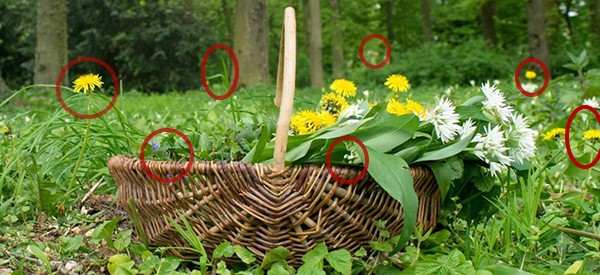
20 Edible And Medicinal Plants You Can Forage In March
After the long cold winter, nothing is more exciting than the first green shoots popping up in the spring.
In March we see the first hints that the long months of eating preserved foods are over. As the snow melts we can begin to forage for the fresh greens to eat and prepare medicinally. When you go out foraging in March be sure to look for these twenty edible, medicinal plants and fungi.
Dandelion (Taraxacum officinale)
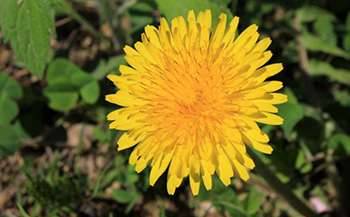
Dandelions are often cursed as pests but the truth is there are many wonderful uses for these sunny flowers.
The greens can be eaten in salads, the flowers infused into oils to make salves, and the roots to make a coffee substitute.
Related: Dandelion Root Infused Honey for Immunity
Cattail Shoots (Typha latifolia)
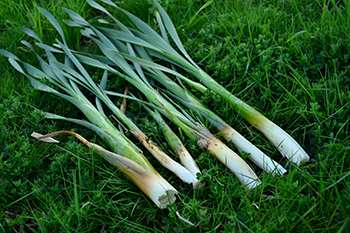
Cattails are a wonderful plant that gives in all four seasons. They are easily recognizable by the fluffy hotdog-shaped pods that give them their name.
In March look for the cattail shoots. You can harvest the shoots when they are 4- 16 inches long. Enjoy them raw or cooked.
Related: Delicious Recipes Using Cattails: The Supermarket of the Swamp
Chickweed (Stellaria media)
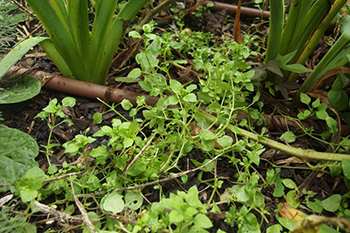
Commonly found in lawns or areas of sun and partial shade, chickweed can be easily harvested in early spring.
The stems can grow up to a foot and a half long with pointed oval-shaped leaves. Chickweed also produces small white flowers. You can distinguish it from other similar plants by the elastic inner stem and the fact it doesn’t have a milky sap. It has a sweet, mild flavor.
It is often used in salads or as a spinach substitute. It is also used traditionally to treat inflammation, as an astringent and to treat skin conditions.
Goosegrass (Galium aparine)
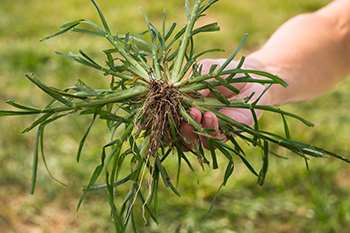 Often considered a weed, goosegrass has medicinal qualities as well as being edible. Know for its sticky hooks, goosegrass is sometimes called cleavers, stickweed, or catchgrass.
Often considered a weed, goosegrass has medicinal qualities as well as being edible. Know for its sticky hooks, goosegrass is sometimes called cleavers, stickweed, or catchgrass.
It can reach heights of four feet and expand outwards ten feet so goosegrass is a good-sized plant.
Medicinally it can be used to treat kidney, bladder, and urinary problems as well as treat skin conditions.
The young tender shoots can be eaten and the seeds roasted for a coffee substitute.
Gorse (Galium aparine)
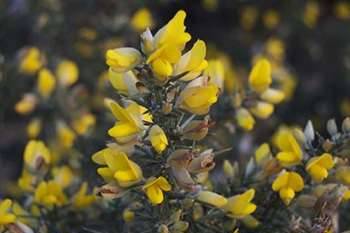
Gorse bushes can grow to be ten feet tall and are known for their impenetrable thorns. While often considered a noxious weed because of the thorns, the buds and flowers can be eaten.
Pickle the buds like capers. Snack on the flowers, add them to salads, or use them to make wine.
Stinging Nettle (Urtica dioica)
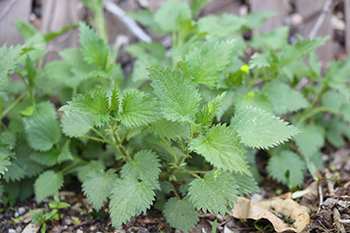 Stinging Nettle is named for the small, sharp hairs that cause skin irritation. Most people avoid the plant because if you touch it you will get an itchy rash.
Stinging Nettle is named for the small, sharp hairs that cause skin irritation. Most people avoid the plant because if you touch it you will get an itchy rash.
However, stinging nettle when cooked is delicious. When foraging nettle, remember to always wear gloves.
Also, don’t forget that it must always be cooked or dried before it is eaten. Related: How to Cook Spring Nettles
Morels (Morchella)
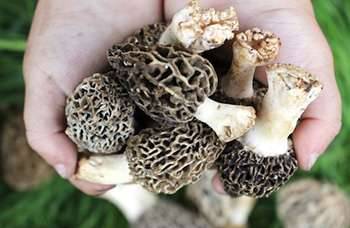
Morels are one of the world’s most prized mushrooms. While they are very difficult to cultivate and they can be found foraging.
Morels are perfect for people just getting started with mushroom foraging because they are easily identifiable by their hollow body and honeycomb-like tops.
Also, all morel varieties are non-toxic when cooked. That being said, you should always make sure that you have any mushrooms identified by an expert if you are unfamiliar with them.
Milkweed (Asclepias)
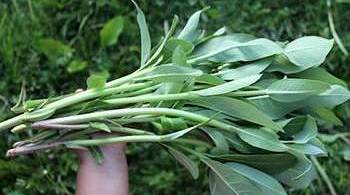
Milkweed is another common weed that can be harvested be eaten in early spring.
Harvest the milkweed buds and shoots when they begin to form.
Then you can simply sautee them with some seasoning and enjoy!
Wild Garlic (Allium Ursinum)
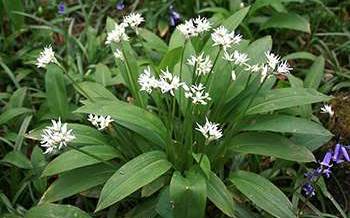
A common plant with bright green pointed leaves, wild garlic can be identified by the strong garlic aroma and small white star-shaped flowers.
The entire plant is edible from the small bulb to the white flowers. Use it to make pesto or add to salads. The stems can be used similarly to chives.
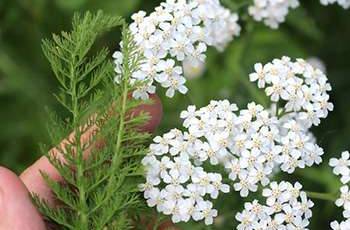
Yarrow (Achillea millefolium)
Yarrow is a beautiful flower that blooms in early spring.
The young leaves can be eaten and the plant has many medicinal qualities.
What You Should Know About Foraging Yarrow
Garlic Mustard (Alliaria petiolata)
Garlic mustard is an invasive weed that can be found in the woods, along roadsides, near creeks, and even in the city.
This prolific weed can be harvested in spring to add a delicious garlicky flavor to hummus, salads, or other dishes.
Wild Violets (Viola sororia)
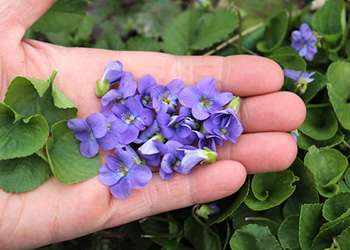
We often forget to think about flowers when we think of edible plants.
Wild violets are a great example of an edible flower you can forage in the spring to add a little beauty to your food.
Wild violets have helped treat many conditions over several centuries. The upper parts of the plant can be used as an infusion to promote sleep.
Taken in a strong tea, they help with lung health by working as an expectorant. Wild violets help treat infections in the upper respiratory tract, as well as colds, congestion, flu viruses, and bronchitis. Overall, they are a gentle immune system stimulant.
Sheep Sorrel (Rumex acetosella)
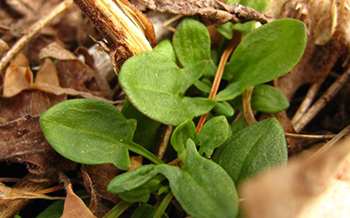
Sheep sorrel is a common lawn weed that can be eaten. It adds a sour tangy taste to your salads and can be used medicinally as well.
But make sure you don’t eat too much or it can give you a headache, make use nauseous or give you diarrhea.
Sorrel is used for reducing sudden and ongoing pain and swelling (inflammation) of the nasal passages and respiratory tract, for treating bacterial infections along with conventional medicines, and for increasing urine flow (as a diuretic). Sorrel is also an ingredient in the herbal cancer treatment Essiac.
In combination with gentian root, European elderflower, verbena, and cowslip flower, sorrel is used orally for maintaining healthy sinuses and treating sinusitis.
Miner’s Lettuce (Claytonia perfoliata)
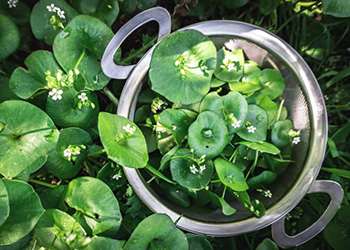
Found on the west coast of the US, Miner’s lettuce is a tasty plant you can forage in early spring. Less bitter than other wild plants, miner’s lettuce has an almost buttery flavor.
The leaves are gently laxative. Apart from its value as a nourishing vegetable that is rich in vitamin C, it can also be taken as an invigorating spring tonic and an effective diuretic.
A poultice of the smashed plants has been applied to rheumatic joints.
Clover (Trifolium)
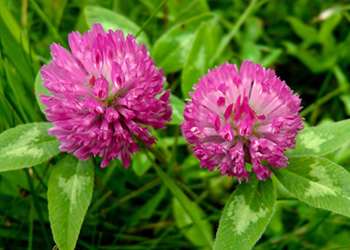
Both red and white clover are common throughout the US.
Recognizable by their trefoil leaves, clover is readily available to forage for food and medicinal uses.
Red Clover is primarily nutritive but also used to support proper lymphatic function, immune support, healthy skin, and proper endocrine function.
Since the plant is so nutritionally complex, it is probably best to use it in its unadulterated form as an extract or tea. Red Clover is generally useful as a tonic for menstrual irregularity and menopause.
Fiddleheads
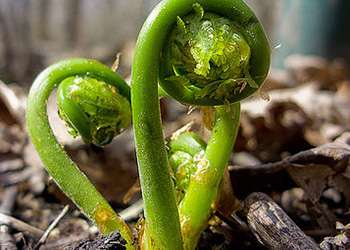
Fiddleheads are the first sprout of a fern. There are many different varieties of edible ferns. Once you’ve found your first fiddleheads, this delicacy is easy to identify.
Usually only available for a few weeks, the tiny fern sprouts add a unique flavor to your cooking.
Fiddleheads have been shown to have up to twice the antioxidant capacity of blueberries! These antioxidants have the ability to boost levels of glutathione (a powerful antioxidant) and ramp up your body’s innate immune system by bolstering its own natural defenses and warding off invading pathogens.
Ramps (Allium tricoccum)
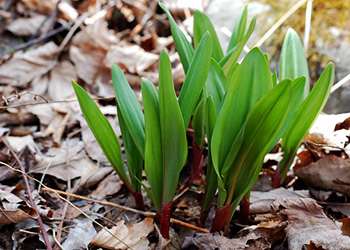
Similar to wild garlic, ramps or wild leeks are another great garlicky plant to forage in March.
High in vitamin C, they are a great addition to your foraging list.
Their high vitamin content and blood-cleansing properties meant that the ramps were highly prized by the American Indians for their nutritional value as well.
The Chippewa decocted the root to induce vomiting, while the Cherokee consumed the ramp to treat colds and made a juice from the plant to treat earache. A tonic of the plant was used by the Iroquois to treat intestinal worms.
Oyster mushrooms (Pleurotus ostreatus)
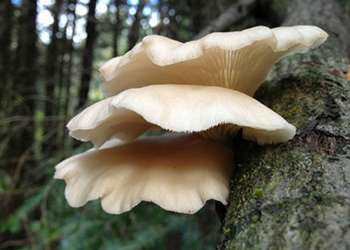
Oyster mushrooms are actually available year-round, so no matter the season you can keep an eye out for these delicious treats.
They are found growing on dead trees and get their name from the distinctive growth pattern, that looks like oyster shells all stack up.
You should always make sure that you have any mushrooms identified by an expert if you are unfamiliar with them.
Henbit (Lamium amplexicaule)
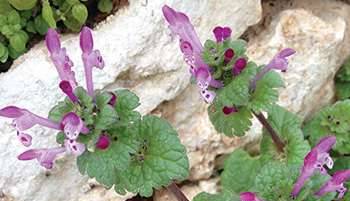
Another common weed, henbit is known for the fact chickens to love to eat it. But many people don’t know that it can also be eaten and used medicinally.
This wild edible is very nutritious. It’s low in calories as well as rich in vitamins, minerals, and fiber. Henbit is a great ingredient to add to your diet if you’re trying to lose weight. It will make you feel fuller for longer and reduce mid-day cravings.
It can help reduce fever, induce sweating, and treat joint aches. Drinking a henbit green smoothie can also help relieve constipation and promote a healthy bowel function. Lastly, henbit herbal tea has stimulant and excitant effects which means it will help relieve stress and anxiety.
Wild Asparagus (Asparagus officinalis)
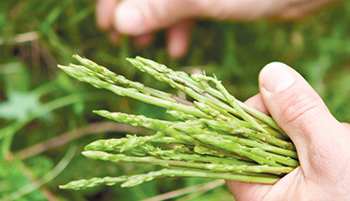
Wild asparagus is really the same plant that we buy at the grocery store only, as the name states, growing in the wild.
They are plants that spread from cultivated varieties and established themselves in ideal conditions.
They want full sun, wet but not too wet, and saline but not too salty. Think the edges of brackish swamps.
Once you find them you can return year after year to the same spot. The spears look just like the ones you would buy at the store. Simply cut the spear close to the ground and enjoy.
As the weather starts to warm and you go out exploring in the woods, make sure you keep an eye out for all these delicious plants that are just beginning to sprout.
After a long winter, freshly foraged food and medicine is always a treat.
You may also like:
 25 Reasons You Should Go and Pick Dandelion Right Now!
25 Reasons You Should Go and Pick Dandelion Right Now!
The US Army’s Forgotten Food Miracle (Video)


Yesss can’t wait to go foraging once the snow melts ❤️
I thought I’d see wild lettuce. There was tons of it (serriola) coming up near Temple TX, then the Ice Age hit. Some plants were almost 3 ft tall. I’m sure there will be more coming. I have a good amount of virosa coming up well near Brenham and it survived the 7 degree freeze pretty well.
Hi Philip,
Thank you for your comment.
We will soon publish a detailed article about Wild Lettuce. You can find it in our column “Plant of The Week”.
So stay tuned 🙂
I was just looking at the curly docks and henbit in my yard. It’s like you read my mind. Thank you for the timely information.
I’m so ready to get out and forage. Thank you for this great post.
Ramps are so prevalent in PA, they actually have a Ramp Festival in Mount Morris, PA. They serve them up all kinds of ways. I’ve had them chopped as a condiment for hot dogs all the way to dipped in chocolate (you read it right) it’s an unusual combination, but it’s not half bad.
On a camping trip a few years ago, our “chef of the day” put ramps in the pancakes.. Everyone’s day started badly! I dehydrate some and grind into a powder for use throughout the year. *Dehydrate outside!
What can you tell me about organic sulfur and the benefits if any.
Hi Amy,
Thank you for your comment.
Organic Sulfur plays a role in treating dozens of health issues, including Joint Pain, Inflammation, and Skin damage.
God bless!
wondering with all the pesticides used today, when you forge for these herbs are you worried about that, or is there something you can do to ensure that is not an issue?
Hi Denise,
Do not harvest from roadsides or other areas where gasoline, oil, and other chemicals could collect. Do not harvest from pristine manicured landscapes, often pesticides and herbicides are used there.
And always place the herbs into a deep bowl of cold water, or into a clean, water-filled sink. Once the herbs are submerged, stir them before leaving them to soak for a moment. Once the dirt has sunk to the bottom of the bowl, remove the herbs by skimming them up and out of the water.
God bless!
Thank you for your help!
We have YELLOW wild “violets” all over our property. Can I use like the purple ones? Or, are they different?
What are some good plants and flowers to look for in the southeast Georgia region for first time foragers? Dandelions for starters and if you could possibly give 3 others? My kids and I love the outdoors but also new to foraging. Just want to start out with easy to identify. Maybe a book to recommend would also be nice😊
I notice that you have both Goosegrass/Cleavers/(Stickywilly) and Gorse listed as Galium Aparine.. per the USDA, I think Gorse is actually Ulex europaeus L (Common gorse) https://plants.usda.gov/home/plantProfile?symbol=ULEU
or Ulex L (Gorse family?) https://plants.usda.gov/home/plantProfile?symbol=ULEX
They are all prolific here..
Gorse is an ‘explosive’ fire hazard and is considered noxious in the fire prone ecology of the PNW.. feel free to harvest abundantly.. lol.. even routhlessly..